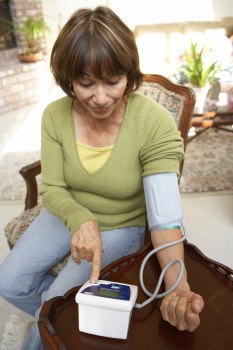Checking Your Own Blood Pressure
Blood pressure checks are a common reason for doctor visits. Yet, for less than the cost of a single appointment, you may be able to purchase your own blood pressure monitor. This way you can check the reading yourself at home.
Blood pressure is the force of blood against the walls of your arteries. Blood pressure readings tend to vary, depending on many factors, including stress levels and time of day. Your blood pressure reading in a doctor's office can be as much as 20 or 30 points higher. The nervousness of being there can be enough to increase blood pressure, according to the National Heart, Lung, and Blood Institute.
Home blood pressure kits

You may purchase blood pressure monitors at pharmacies, medical supply stores, and discount chain stores. An electronic digital monitor that is battery operated is often easier to use than the more traditional blood pressure cuff. Electronic monitors usually cost more.
It’s important to check the accuracy of either type of monitor every so often. One way to make sure your monitor is accurate is to take it with you to your next doctor appointment. Take your blood pressure with your monitor and compare it with the reading from your doctor’s monitor.
Ask your health care provider or pharmacist to recommend a monitor for you. Keep in mind that if you have a large upper arm, you'll need a special, large cuff to get a proper reading.
Read the instructions
Each type of blood pressure monitor works differently. Be sure to read the instructions that come with yours. Ask your doctor, nurse, or pharmacist to teach you how to use it. Many people can check their own blood pressure at home without difficulty. Some need assistance from a family member or friend.
Your home blood pressure reading is more likely to be accurate if you do the following:
-
Don't take readings within a half-hour after smoking, exercising, or drinking beverages with caffeine.
-
Take 2 or 3 readings at least 2 minutes apart, and average the results.
-
Take readings at different times during the day, or on several days at different times.
-
Before you take your blood pressure, sit for 5 minutes with your back supported and your feet flat on the ground. Rest your arm on a table at the level of your heart.
-
Use the bathroom before taking your reading. A full bladder can change the results.
Blood pressure is recorded as 2 numbers: the systolic pressure, when the heart beats, over the diastolic pressure, when the heart relaxes between beats. The systolic number comes first, or on top. The diastolic number is second, or on the bottom. Both numbers in a blood pressure reading are important. As we grow older, systolic blood pressure is particularly important.
Get immediate medical care if your blood pressure is much higher or lower than expected. Whenever you visit your health care provider, take your blood pressure record with you.